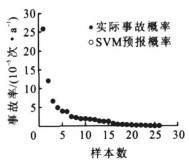Prediction method of ship impacting bridge based on least square support vector machines
Article Text (Baidu Translation)
-
摘要: 为了提高桥梁与桥区通航船舶的安全性, 提出了一种船撞桥概率智能预测方法。以桥墩跨径、水流速度、水流方向与桥墩连线法线方向夹角以及航道弯曲度为系统输入, 以单航次船撞桥事故率为系统输出, 应用最小二乘支持向量机进行了船撞桥概率估算。结合实际航道, 选择了长江和黑龙江上12座桥梁的洪水期、中水期和枯水期3个时段的样本数据进行验算, 并与神经网络船撞桥概率估算结果进行对比。对比结果表明: 支持向量机方法能准确地预报船撞桥概率, 具有全局最优解, 并且收敛性和学习效率均优于神经网络。Abstract: In order to improve the safety of bridge and ship, an intelligent prediction method of the probability on ship impacting bridge was proposed based on least square support vector machines.The transverse span of piers, current velocity, current direction relative to bridge and waterway curvature were taken as the inputs of the method, while the output is the accident probability of pervoyage, some data samples of 12 bridges over Yangtze River and Heilongjiang River during the periods of flood, normal and low water respectively were chosen, the method was validated by the data, and the prediction results of neural network method and the proposed method were compared.Comparison result shows that the method can accurately predict the probability of ship impacting bridge, its prediction probability is a globally optimal resolution, and its convergent velocity and learning efficiency are better than that of neural network method.
-
表 1 三层前馈BP网络训练误差
Table 1. Training errors of three-layer feedforward neural network
迭代次数 均方差 迭代次数 均方差 4 100/5 000 6.039 54 4 600/5 000 1.513 91 4 200/5 000 7.789 51 4 700/5 000 0.807 20 4 300/5 000 1.244 49 4 800/5 000 2.668 63 4 400/5 000 1.492 09 4 900/5 000 0.438 80 4 500/5 000 1.146 96 5 000/5 000 0.792 37 -
[1] Larsen O D. Ship collision with bridges—the interaction between vessel traffic and bridge structures[R]. Zurich: International Association of Bridge and Structural Engineering, 1993. [2] Knott MA, Larsen O D. Guide specification and commentary for vessel collision design of highway bridges[R]. Virginia: Depart ment of Transportation, Federal Highway Administration, 1990. [3] 项海帆, 范立础, 王君杰. 船撞桥设计理论的现状与需进一步研究的问题[J]. 同济大学学报: 自然科学版, 2002, 30(4): 386-392. https://www.cnki.com.cn/Article/CJFDTOTAL-TJDZ200204001.htmXiang Hai-fan, Fan Li-chu, Wang Jun-jie. State of art of ship collision designfor bridges andfuture research[J]. Journal of Tongji University: Natural Science, 2002, 30(4): 386-392. (in Chinese) https://www.cnki.com.cn/Article/CJFDTOTAL-TJDZ200204001.htm [4] 戴彤宇. 船撞桥及其风险分析[D]. 哈尔滨: 哈尔滨工程大学, 2002. [5] 罗林阁, 曹映泓, 陈国虞, 等. 船舶撞击桥梁的撞击力计算方法探讨[J]. 中外公路, 2006, 26(5): 78-81. https://www.cnki.com.cn/Article/CJFDTOTAL-GWGL200605033.htmLuo Lin-ge, Cao Ying-hong, Chen Guo-yu, et al. Calculation method of force on vessel impacting bridge[J]. Journal of China and Foreign Highway, 2006, 26(5): 78-81. (in Chinese) https://www.cnki.com.cn/Article/CJFDTOTAL-GWGL200605033.htm [6] Liu Jian-cheng, Gu Yong-ning, Hu Zhi-qiang. Simulation of ship-bridge collision based on FE model of vessel impact forces on bridges[J]. Journal of Ship Mechanics, 2003, 7(3): 107-117. [7] 李升玉, 王曙光, 刘伟庆, 等. 船舶与桥墩防撞系统碰撞的数值仿真分析[J]. 自然灾害学报, 2006, 15(5): 100-106. https://www.cnki.com.cn/Article/CJFDTOTAL-ZRZH200605015.htmLi Sheng-yu, Wang Shu-guang, Liu Wei-qing, et al. Numerical simulations of ship collision with protective devices of bridge pier[J]. Journal of Natural Disasters, 2006, 15(5): 100-106. (in Chinese) https://www.cnki.com.cn/Article/CJFDTOTAL-ZRZH200605015.htm [8] InCom WG19(Working Group19of the Inland Navigation Commission). Ship collision due to presence of bridges[R]. Belgium: International Navigation Association, 2001. [9] Berlin K B. Structural reliability analysis for vessel impact on bridges[D]. Texas: The University of Texas, 2005. [10] 杨渡军. 桥梁的防撞保护系统及其设计[M]. 北京: 人民交通出版社, 1990. [11] Vapnik V N. 统计学习理论[M]. 许建华, 张学工, 译. 北京: 电子工业出版社, 2004. [12] 刘德新, 吴兆麟, 贾传荧. 多层次多目标重点避让船模糊优选模型[J]. 交通运输工程学报, 2005, 5(1): 49-52. http://transport.chd.edu.cn/article/id/200501012Liu De-xin, Wu Zhao-lin, Jia Chuan-ying. Multi-layer and multi-object fuzzy optimization model of main target ship[J]. Journal of Traffic and Transportation Engineering, 2005, 5(1): 49-52. (in Chinese) http://transport.chd.edu.cn/article/id/200501012 [13] 焦李成. 神经网络系统理论[M]. 西安: 西安电子科技大学出版社, 1990. -





 下载:
下载:



